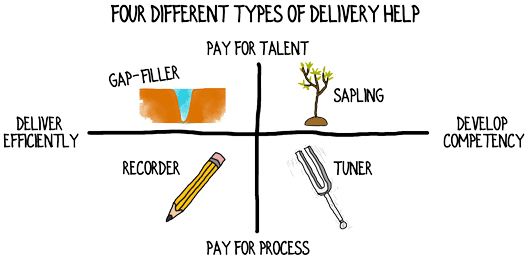Delegating consulting projects to new hires and subcontractors is prone to high levels of failure and frustration.
The checklist below will help you deploy new resources better.
You’ve won a big forecasting engagement from Mercator Projections, Inc. (hooray). However, since your consulting firm’s current capacity is insufficient to deliver the Mercator Projections projections project, you need to hire an additional hand or subcontract to an outside resource.

Fortunately, you know Guy Huchipsin, whose capabilities neatly match the boundaries of this project.
Stop.
Before you hire Guy and ask him to navigate the project’s requirements, your consulting firm has four overlapping-but-distinct sets of decisions to make.
Four Consulting Firm Delegation Decisions
Decision #1: Deliver Efficiently vs. Develop Competencies
Do you want to deliver a high-quality output to your client as precisely and efficiently as possible, or do you want to teach Guy a new competency?
If Guy is a subcontractor, you may not prioritize competency development.
However, if Guy is a new hire, this engagement could orient him on your consulting firm’s approach or it could bolster critical consulting skills such as strategic thinking.
Learning is inefficient. Conversely, efficient, precisely defined processes don’t develop competencies (beyond following the process).
Decision #2: Pay for Talent vs. Pay for Process
Irrespective of your Decision #1, you can invest in improving your process (even more) or hire a resource with the smarts and ability to produce your desired outcome within your current, imperfect process.
If Guy is highly talented, he may be overqualified and bored on a project that your consulting firm already has completely mapped out. Or, if Guy is very junior, he may not be competent to succeed on an engagement with an un(der)-developed approach.

Decision #3: Extent of Oversight
For each part of your consulting project, determine how closely you will supervise your new resource. The four levels below outline the extent to which you will oversee the task.*
Embedded in oversight is your direction on which conflicts, problems and ambiguities should be escalated versus handled by the new resource; however, you may want to explicitly outline your escalation rules.
Level 1 – Talk to me before you do anything.
Level 2 – Report back to me on a regular basis.
Level 3 – Tell me when it’s done.
Level 4 – Now that it’s yours, I plan to forget it forever.
Decision #4: Degree of Latitude
For each part of the project and each aspect of consulting delivery, determine how much leeway you’re giving Guy to determine how to accomplish the tasks you’re assigning to him.
Level O – Follow our precise processes and use our scripts/templates as designed.
Level o – Follow our processes, using your judgment to tweak and adjust as necessary.
Level y – Do it your way, while conforming to our QA checklist.
Level Y – Do it your way, as long as the objectives are met.

Using the Four Decisions in a Checklist
Ultimately, when you hand Guy an outline of the project expectations, deliverables, etc. you’ll include a summary of the four decisions.
Break out the different parts of your consulting project if your desired level of oversight or latitude vary.
Also consider whether oversight and latitude vary across the different aspects of consulting (e.g., work-plan development, solution development, client communication, etc.).
It looks something like this:
Project: Mercator Projections Projections Project
Resource: Guy Huchipsin
Priority: Deliver Efficiently –X––––––––– Develop Competency
Expectation: Focus on Output ––––X–––––– Focus on Process Improvement
| Project Phase | Oversight | Latitude | Comments |
| Interviews | 3 | o | Tweak our interview guide, as necessary |
| Analysis | 3 | Y | Let us know if you have questions |
| Work Sessions | 2 | O | Bi-weekly check-ins; pre-clear all client communications |
| Solution Development | 1 | y | Refer to our examples for typical solutions; review all ideas with us before implementing |
Of course, you also include the objectives, success metrics, and other important details about the project.
Is developing the checklist a bit of a pain? Yes. It takes up to 15 minutes to complete the checklist for one resource assigned to a project.
Then again, if you won’t devote 15 minutes to outfitting your new resource with a compass and roadmap, you can’t expect them to reach the land of success.
What else does it help to think through in advance when you’re hiring an employee or subcontractor to supplement your consulting firm’s staff?
Text and images are © 2024 David A. Fields, all rights reserved.

 David A. Fields Consulting Group
David A. Fields Consulting Group 

David, thank you for sharing this valuable strategy and checklist. While it’s originally designed for integrating new hires or contractors in a consulting firm, the principles can also apply to hiring and onboarding in client companies. Often, new hires in companies lack specific guidance from their team managers, which can hinder their successful transition and performance in their new roles. While orientation trainings exist, they tend to be too general and lack team-specific expectations for job performance and team success.
That’s very insightful point, VR. Our clients are often just as bad at onboarding as we are–sometimes even worse. You can help your clients in that area by guiding them through the same four decisions (in addition to sketching out other details of a role, such as the 3 Rocks.)
Thank you for taking the conversation in a new, valuable direction, VR!
Great detail and I really like the oversight and latitude levels as a job aid for supervisors of any role. I’ve seen this process fall back on the magic triangle (good-fast-cheap, pick 2) model and these details and help fill in the blanks.
Exactly, Bill. Good-fast-cheap doesn’t give enough direction for someone to succeed. “Okay, you hired me because I’m fast and cheap… did you provide the fool-proof recipe for me?” The checklist helps you realize where you need to provide detailed instruction and where, if you don’t have those details, you’ll have to pay for a higher level of talent.
Thanks for jumping into the conversation today, Bill!
Great information as always!
Thank you for that feedback, Kevin. Reactions from smart people like you are always welcome!
Hi David,
I just wanted to clarify something. For latitude, it really means having a pre-defined process, vs. figuring out how to do it? Because, in the case of 1-y (for solution development), they aren’t necessarily “doing it their way” since they have to run it by you first, and you can overrule / have them modify it?
Excellent question! Latitude refers to who’s defining the approach, whether it’s pre-defined or not. For instance, with a 1-y you may say, “Come to me with your ideas and thoughts for how to develop the solution. In that conversation, I’ll share the success criteria or parameters for developing a solution and we’ll agree on the next step. You’ll perform the next step then come back to me again with your next set of recommendations.” In other words, the other person does most of the thinking and work, but with heavy levels of supervision.
Separating latitude and oversight is important for the very reason you just noted. People tend to collapse them, but they’re quite different kettles of chocolate.
Thanks for the illuminating question, which forced further clarification, Praveen!
Thank you David. This is my firm’s biggest challenge and we will definitely incorporate this into our practice.
Ben, you’re not alone with the challenge. When you’re so busy that you need to hire, it feels nigh on impossible to find time to do the necessary prework for a hire. Yet, it pays off every time. This 4-decision framework, the “Task collaboration form” we use and, especially the 3 Rocks frameworks are all absolute gold when you’re bringing on additional staff/contractors.
I’m glad you spoke up about your situation, Ben. Plenty of other readers are relieved just knowing they’re not alone in their struggles!